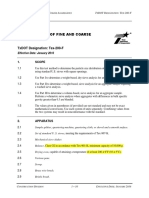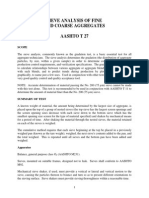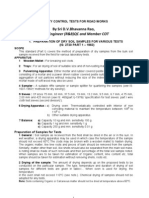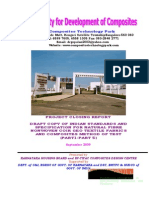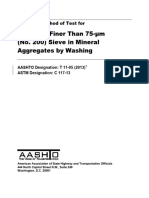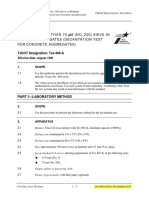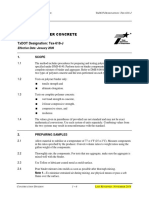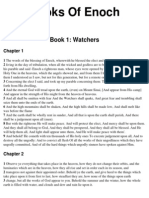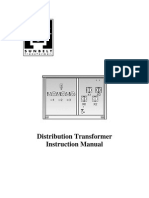Sieve Analysis
Sieve Analysis
Uploaded by
Binod MaharajanCopyright:
Available Formats
Sieve Analysis
Sieve Analysis
Uploaded by
Binod MaharajanCopyright
Available Formats
Share this document
Did you find this document useful?
Is this content inappropriate?
Copyright:
Available Formats
Sieve Analysis
Sieve Analysis
Uploaded by
Binod MaharajanCopyright:
Available Formats
SIEVE ANALYSIS OF FINE AND COARSE AGGREGATES
TXDOT DESIGNATION: TEX-200-F
Test Procedure for
SIEVE ANALYSIS OF FINE AND COARSE AGGREGATES
TxDOT Designation: Tex-200-F
Effective Date: August 2008
Texas Department of Transportation
1.
1.1 1.2 1.3 1.4
SCOPE
Use this test method to determine the particle size distribution of aggregate samples, using standard U.S. sieves with square openings. Use Part I to determine a weight-based, dry-sieve analysis for an aggregate sample. Use Part II to determine a weight-based, sieve analysis for an aggregate sample requiring a washed sieve analysis. Use Part III to determine a volume-based, sieve analysis for an aggregate sample. Perform a volumetric sieve analysis when aggregates with differences in bulk specific gravity greater than 0.3 are blended. The values given in parentheses (if provided) are not standard and may not be exact mathematical conversions. Use each system of units separately. Combining values from the two systems may result in nonconformance with the standard.
1.5
2.
2.1 2.2 2.3 2.4 2.5 2.6 2.7 2.8 2.9
APPARATUS
Sample splitter, quartering machine, quartering cloth, or shovel and a smooth surface. Set of standard U. S. sieves, meeting the requirements of Tex-907-K. Mechanical sieve shaker. Balance, readable to 0.1 g, with accuracy to 0.5 g. Drying oven, capable of attaining the temperature specified in the test procedure. Various pans. Scoop. Brass wire brush. Bristle brush.
CONSTRUCTION DIVISION
1 10
EFFECTIVE DATE: AUGUST 2008
SIEVE ANALYSIS OF FINE AND COARSE AGGREGATES
TXDOT DESIGNATION: TEX-200-F
3.
3.1
PREPARING MATERIAL SAMPLE
Follow these steps to properly prepare an aggregate that has been sampled from a stockpile. Do not use these steps if performing a sieve analysis on material obtained from an ignition oven or extraction sample. Place a representative sample of processed aggregate in oven and dry to constant weight at a minimum temperature of 200F (93C) or dry aggregates a pan over an open flame with frequent stirring. For field testing of Portland cement concrete aggregate, it is not necessary to completely dry, but merely to surface dry, the coarse aggregate. Dry rock asphalt samples at 140 5F (60 3C). Note 1For control testing, particularly where rapid results are desired, it is generally not necessary to dry rock asphalt aggregate. For coarse materials (major portion retained on the No. 8 [2.36 mm] sieve), quarter the sample to the required size as shown in Table 1 using one of the following methods: Sample splitter Quartering cloth Quartering machine Mix on a smooth clean surface with a large flat scoop or shovel until blended, and quarter with a straight edge.
3.2
3.2.1 3.2.2
3.3
3.4 3.5 3.6
For fine materials (major portion passing No. 8 [2.36 mm] sieve) thoroughly blend sample and take small portions from several places in the pan to make up the test sample. For control testing, create the test sample for all size aggregates by blending small portions taken from several places in the pan. For plant control testing, weigh aggregates in the same proportions as used in the bituminous mixture being produced, then combine and sieve to yield the combined aggregate gradation. Reverse Sections 3.6 through 3.2 when this proves more practical.
3.7
CONSTRUCTION DIVISION
2 10
EFFECTIVE DATE: AUGUST 2008
SIEVE ANALYSIS OF FINE AND COARSE AGGREGATES
TXDOT DESIGNATION: TEX-200-F
Table 1Minimum Size of Samples Nominal Maximum Size of Particles, Passing Sieve*** Minimum Weight of Field Sample, g (lb.)** Fine Aggregate No. 8 (2.36 mm) No. 4 (4.75 mm). 4500 (10) 4500 (10) Coarse Aggregate 3/8 in. (9.75 mm) 1/2 in. (12.5 mm) 3/4 in. (19.0 mm) 1 in. (25.0 mm) 1-1/2 in. (37.5 mm) 2 in. (51.0 mm) 4500 (10) 4500 (10) 4500 (10) 6800 (15) 9000 (20) 13,600 (30) 1000 g (2 lbs.) 1500 g (3 lbs.) 2000 g (4 lbs.) 3000 g (6 lbs.) 4000 g (8 lbs.) 4000 g (8 lbs.) 500 (1.1) 500 (1.1) Minimum Weight of Sample for Test, g (lb.)*
PART IDRY SIEVE ANALYSIS (BASED ON WEIGHT)
4.
4.1
SCOPE
Use this procedure to determine a weight-based, dry-sieve analysis for an aggregate sample.
5.
5.1 5.2 5.3 5.4 5.5 5.5.1
PROCEDURE
Follow the steps in Section 3 to prepare the material sample. Accurately weigh the total sample to the nearest 0.1 g. Record this weight as WT under Section 8. Place the set of sieves, with the largest opening on top, into a pan and pour the aggregate onto the top sieve. Separate the material into a series of particle sizes using the sieves required by the material or project specifications. Use a mechanical shaker if available. If a mechanical shaker is not available, proceed to Section 5.6. Establish a shaking time for different types of aggregates that will assure proper sieving of the material without degradation.
CONSTRUCTION DIVISION
3 10
EFFECTIVE DATE: AUGUST 2008
SIEVE ANALYSIS OF FINE AND COARSE AGGREGATES
TXDOT DESIGNATION: TEX-200-F
5.5.2
When the required mechanical shaking time is complete, hand sieve by lateral and vertical motion of the sieves with a jarring action that keeps the material moving continuously over the surface of the sieves. Continue hand sieving until no material passes through the sieve. Proceed to Section 5.7. The entire sample may be hand sieved using the following steps. Hand sieve by lateral and vertical motion of the sieves with a jarring action that keeps the material moving continuously over the surface of the sieves. Continue hand sieving until no material passes through the sieve. Brush particles clinging to each sieve into the next lower sieve with a bristle brush. Ensure no material is lost. Determine the individual weights to the nearest 0.1 g of aggregate retained on each sieve and record these weights. Place an empty pan on the scale and tare or zero out its weight. Pour the retained aggregate into the empty pan and record this weight. Re-tare the pan for the next size sieve or tare a new pan if required to keep the material separate. Repeat this process until the weight of the material on each sieve and the retaining pan (typically the material passing the No. 200 sieve) has been recorded. Report the percentages to the nearest 0.1% for each size of aggregate retained on each sieve as set forth by the specification requirements. Refer to Section 8 and Section 9. Make the original sieve analysis a 'total retained' analysis by weighing the material cumulatively, placing the material retained on one sieve directly on top of the previously weighed material from the larger size sieve, already on the balance. Note the difference. Take care to prevent loss of material during the sieving operation. However, if there is a small discrepancy (less than 0.2%) between the original dry weight of sample and the sum of the weights of the various sizes assume the small amount as particles passing the smallest size sieve and use the original weight. If the discrepancy is large (greater than 0.2%), check the weights of the various sizes or rerun the analysis with a new sample to correct the error.
5.5.3 5.5.4 5.6 5.6.1 5.6.2 5.7 5.8 5.8.1 5.8.2 5.8.3 5.8.4 5.9 5.10
5.11
CONSTRUCTION DIVISION
4 10
EFFECTIVE DATE: AUGUST 2008
SIEVE ANALYSIS OF FINE AND COARSE AGGREGATES
TXDOT DESIGNATION: TEX-200-F
PART IIWASHED SIEVE ANALYSIS (WHEN SPECIFIED BASED ON WEIGHT)
6.
6.1
SCOPE
Use this procedure to determine a weight-based, sieve analysis for an aggregate sample, requiring a washed sieve analysis.
7.
7.1
PROCEDURE
Follow the steps in Section 3 to prepare the material sample. Note 2Test a minimum of two samples from each stockpile when developing a mixture design in accordance with Tex-204-F. Weigh the total dry sample to the nearest 0.1 g and record the weight as WT under Section 8. Place the sample in a wash pan and inundate with clean potable water. Gently mix the water into the sample with the hands to break up clay lumps or "sand balls" and loosen the coating of fines on the coarse aggregate. Rinse any sample particles clinging to the hands back into the wash pan. Soak the sample a minimum of 10 minutes. A sample that contains very high clay content may require overnight soaking. After soaking, remix the sample with the hands as noted in Sections 7.4 and repeat Section 7.5. Place a set of sieves, a No. 8 (2.36 mm) and a No. 200 (75 m), in a pan or over an open sink. Flush the wetted sample over the set in small batches to prevent overloading (clogging) and damage to the No. 200 (75 m) sieve. When the material retained on the No. 8 (2.36 mm) sieve is adequately washed, remove it and place in a clean drying pan. Continue to wash the material retained on the No. 200 (75 m) sieve until the wash water runs clean. Then place it in the drying pan with the previously cleaned No. 8 (2.36 mm) material. Continue the process until entire sample has been washed over the set of sieves. After the final wash, the sieves must be rinsed over the drying pan. After the fines have settled, decant excess water from the drying pan and dry the washed sample to a constant weight.
7.2 7.3 7.4 7.5 7.6
7.7 7.8
7.9
7.10
7.11 7.12
CONSTRUCTION DIVISION
5 10
EFFECTIVE DATE: AUGUST 2008
SIEVE ANALYSIS OF FINE AND COARSE AGGREGATES
TXDOT DESIGNATION: TEX-200-F
7.13 7.14 7.15 7.16
Weigh the dried washed sample and record the weight as Ww under Section 8. Determine the sieve analysis of the dried washed sample as described in Part I. Report the percentages to the nearest 0.1% for each size of aggregate retained on each sieve as set forth by specification requirements. See Sections 8 and 9. Take care to prevent loss of material during the sieving operation. However, if there is a small discrepancy (less than 0.2%) between the original dry weight of sample and the sum of the weights of the various parts assume the small amount as particles passing the smallest size sieve and use the original weight. If the discrepancy is large (greater than 0.2%), check the weights of the various sizes or rerun the analysis with a new sample to correct the error.
8.
8.1
CALCULATIONS
Dry Sieve Analysiscalculate the percentages by weight retained between consecutive sieves:
X W = 1 100 W T
Where: W = Percentage by weight retained between consecutive sieves X1 = Weight of oven dry aggregate passing one sieve size and retained on the next smaller sieve size or pan WT = Total weight of original dry sample which equals the sum (X1 + X2, etc.) of all the weights of aggregate retained on sieve sizes and includes the portion which passes the smallest size sieve used. 8.2 Washed Sieve Analysisthe calculations are the same as for dry sieve analysis except the percent finer than the No. 200 (75 m) is:
Pas sin g No. 200 (75m) =
(WT WW ) 100 WT
Where: WW = Total weight of the washed dry sample WT = Total weight of the original dry sample. Note 3A small amount of additional passing No. 200 (75 m) material is usually found during the sieve analysis performed after washing. Add this to the pass No. 200 (75 m) percentage calculated above.
CONSTRUCTION DIVISION
6 10
EFFECTIVE DATE: AUGUST 2008
SIEVE ANALYSIS OF FINE AND COARSE AGGREGATES
TXDOT DESIGNATION: TEX-200-F
9.
9.1
REPORT FORMS
Use Sieve Analysis of Non-Surface Treatment Aggregates in Excel to calculate both a dry or washed sieve analyses. Use Sieve Analysis of Surface Treatment Aggregate in Excel to calculate the sieve analysis of aggregates for surface treatment applications.
9.2
PART IIIVOLUMETRIC SIEVE ANALYSIS
10.
10.1
SCOPE
Use this procedure to determine a volume-based, sieve analysis for an aggregate sample. Perform a volumetric sieve analysis when aggregates with differences in bulk specific gravity greater than 0.3 are blended.
11.
11.1 11.1.1 11.1.2 11.1.3
APPARATUS
Apparatus listed in Section 2, with the addition of the following items: Glass graduates, 68 fl. oz. (2000 ml), with 0.68 fl. oz. (20 ml) graduations; and 8.45 fl. oz. (250 ml), with 0.07 fl. oz. (2 ml) graduations. Wide-mouth funnel. Water or other appropriate liquids.
12.
12.1 12.2 12.3 12.4 12.4.1 12.4.2
PROCEDURE
Follow the steps in Section 3 to prepare the material sample. Place the set of sieves, with the largest opening on top, into a pan and pour the aggregate onto the top sieve. Perform a sieve analysis on the aggregate sample by separating the material into a series of particle sizes using sieves required by the material or project specifications. The use of a mechanical sieve shaker is the preferred method for separating the materials into the specified sizes. If a mechanical shaker is not available, proceed to Section 12.5. Establish a shaking time for different types of aggregates that will assure proper sieving of the material without degradation. When the required mechanical shaking time is complete, hand sieve by lateral and vertical motion of the sieves with a jarring action that keeps the material moving continuously over the surface of the sieves.
CONSTRUCTION DIVISION
7 10
EFFECTIVE DATE: AUGUST 2008
SIEVE ANALYSIS OF FINE AND COARSE AGGREGATES
TXDOT DESIGNATION: TEX-200-F
12.4.3 12.5 12.5.1 12.5.2 12.6 12.7 12.8
Continue hand sieving until, by visual observation, no material passes through the sieve. The entire sample may be hand sieved using the following steps: Hand-sieve by lateral and vertical motion of the sieves with a "jarring" action that keeps the material moving continuously over the surface of the sieves. Continue hand-sieving until, by visual observation, no material passes through the sieve. Fill the glass graduate with water or other appropriate liquid, enough to cover entire sample. Make an initial reading of the liquid level and record on the 'Volumetric Sieve Analysis Worksheet.' Place the aggregate retained on the largest sieve size into the graduate. Note 4This step may be reversed if analysis involves certain absorptive aggregates. Eliminate entrapped air from the graduate, particularly after adding the fine aggregate, by gently rolling the graduate or stirring the aggregate prior to taking a reading. Read the liquid level within 20 seconds and record on the worksheet. Prior to adding each aggregate size, re-check the liquid level reading. If it differs from the liquid level recorded for the previous aggregate size, use the new reading as the initial liquid level prior to adding the next aggregate size. The object of the procedure is to measure the volume change of the liquid for each size aggregate. Determine the volume of each size of aggregate by subtracting the liquid reading prior to the addition of each size of aggregate from the liquid reading after the addition of each size of aggregate, and enter the result in column 3 of the worksheet. The difference in initial and final readings will be the total volume of the aggregate. Divide the volume of each aggregate fraction by the total aggregate volume to determine the percent retained on each sieve and enter in Column 4. This percent will be an expression of each size as a portion of the total aggregate. Total percent retained and percent passing may then be calculated from these values.
12.9 12.10 12.11
12.12
12.13
12.14
PART IVVOLUMETRIC SIEVE ANALYSIS OF LIGHTWEIGHT AGGREGATE (WITH SPECIFIC GRAVITIES LIGHTER THAN WATER)
13.
13.1
SCOPE
Use this procedure to determine precise data relating to aggregate compounds in which some percentage of the total volume includes material that is lighter than water or the usual suspension medium.
CONSTRUCTION DIVISION
8 10
EFFECTIVE DATE: AUGUST 2008
SIEVE ANALYSIS OF FINE AND COARSE AGGREGATES
TXDOT DESIGNATION: TEX-200-F
14.
14.1
APPARATUS
Same apparatus as listed for Part III with the addition of a plunger (See Figure 1.)
Perforated Disc
Diameter to provide snug fit in graduated cylinder being used 13mm (0.5 in) dowel rod or equivalent. Dowel rod length approximately equal to depth of graduated cylinder used. Calibration mark. (Approximately 51mm [2 in] above disc.) Perforated metal or plastic disc attached to dowel rod. Note: The perforation in the disc should be small enough to permit the passage of any small floating particle.
Figure 1Volumetric Sieve Analysis-PlungerDiagram
15.
15.1 15.2
PROCEDURE
Perform Part III, Sections 12.1 through 12.5. Fill the graduate with water or other appropriate liquid, enough to cover entire sample plus at least an additional 2 in. (51 mm). The additional 2 in. (51 mm) is required to ensure that the calibration mark on the plunger is submerged when taking a reading. Slowly lower the plunger into the liquid, permitting air and liquid to percolate through the holes in the perforated disc, until the liquid level reaches the calibration mark on the plunger handle. Trap all material beneath the plunger disc, eliminating any air prior to making readings. With the liquid level on the calibration mark of the plunger handle, read and record the liquid level from the scale on the graduated cylinder. This is the 'zero' or 'initial' reading. Remove the plunger and place the aggregate retained on the largest sieve into the graduate. Begin with the finest size when preparing more absorptive materials.
15.3
15.4 15.5 15.6
CONSTRUCTION DIVISION
9 10
EFFECTIVE DATE: AUGUST 2008
SIEVE ANALYSIS OF FINE AND COARSE AGGREGATES
TXDOT DESIGNATION: TEX-200-F
15.7 15.8 15.9 15.10 15.11
Slowly lower the plunger into the liquid until the level rises to the calibration mark on the plunger handle. Read and record the liquid level from the calibrated scale on the graduated cylinder within 20 seconds of the aggregate being added. Check the liquid level when ready to add the next aggregate size. Record this as the initial reading and pour in the next sieve-size material. Make this reading within 20 seconds, in the same manner described above. Continue this procedure for each sieve size material. Note 5Take care when lowering the plunger into the liquid so that floating particles do not slip by the edge of the plunger disc. Make calculations in the same manner described previously under Part III. Improve the precision of this procedure by using two graduates: 7.5 fl. oz. (250 ml) graduate with 0.06 fl. oz. (2 ml) graduationsThe volumes of small amounts of aggregate of any given size can be measured with a greater precision in the 7.5 fl. oz. (250 ml) graduate. 60 fl. oz. (2000 ml) graduate with 0.6 fl. oz. (20 ml) graduationsThe volumes of the larger amounts of aggregate of any given size can be measured in the 60 fl. oz. (2000 ml) graduate.
15.12 15.13
15.14
All that is necessary is to follow the given procedure, reading the liquid level before and after each size aggregate is put into a graduate. Subtracting the before reading from the after reading will yield the volume of the sample put into the graduate.
16.
16.1
ARCHIVED VERSIONS
Archived versions are available.
CONSTRUCTION DIVISION
10 10
EFFECTIVE DATE: AUGUST 2008
You might also like
- Drug Study (Ferrous Sulfate)Document5 pagesDrug Study (Ferrous Sulfate)JM80% (10)
- Kottak Anthropology - Chapter 1Document22 pagesKottak Anthropology - Chapter 1Sophia Nguyen75% (4)
- 2015 - Standard Method of Test For Sieve Analysis of Fine and Coarse AggregatesDocument9 pages2015 - Standard Method of Test For Sieve Analysis of Fine and Coarse AggregatesSameh AhmedNo ratings yet
- AASHTO T 27 - Sieve Analysis of Fine and Coarse Aggregates PDFDocument40 pagesAASHTO T 27 - Sieve Analysis of Fine and Coarse Aggregates PDFShazwanShah75% (4)
- Hal Draper - Karl Marx's Theory of Revolution, Vol. 1 - State and Bureaucracy 1 (1977, Monthly Review Press)Document379 pagesHal Draper - Karl Marx's Theory of Revolution, Vol. 1 - State and Bureaucracy 1 (1977, Monthly Review Press)Mauricio FuentesNo ratings yet
- Krys Talk ReteDocument2 pagesKrys Talk ReteCésar GomesNo ratings yet
- Sieve Analysis of Fine and Coarse Aggregates: Test Procedure ForDocument10 pagesSieve Analysis of Fine and Coarse Aggregates: Test Procedure ForHong VeasnaNo ratings yet
- Sieve Analysis of Fine and Coarse Aggregates: Test Procedure ForDocument10 pagesSieve Analysis of Fine and Coarse Aggregates: Test Procedure ForPaul MaduagwuNo ratings yet
- Sieve Analysis of Fine and Coarse Aggregates: Test Procedure ForDocument9 pagesSieve Analysis of Fine and Coarse Aggregates: Test Procedure ForMuhammad AfrasiyabNo ratings yet
- Aashto T27-T11Document14 pagesAashto T27-T11Rifki Aulia60% (5)
- Aashto T 27Document4 pagesAashto T 27Erick TuhNo ratings yet
- Particle Size Analysis of Soils: Test Procedure ForDocument13 pagesParticle Size Analysis of Soils: Test Procedure ForDayner M Sanchez GarciaNo ratings yet
- 2 Sieve GradingDocument24 pages2 Sieve Gradingalsami67No ratings yet
- Mechanical Analysis of Extracted Aggregate: Standard Method of Test ForDocument6 pagesMechanical Analysis of Extracted Aggregate: Standard Method of Test Forclint silNo ratings yet
- Sieve Analysis of Fine and Coarse Aggregate: Test Procedure ForDocument5 pagesSieve Analysis of Fine and Coarse Aggregate: Test Procedure Forzulaffan zairifliNo ratings yet
- LS-297 - Rev 34 - May 2020Document9 pagesLS-297 - Rev 34 - May 2020ming_zhu10No ratings yet
- Aashto T112Document6 pagesAashto T112Yudith Bdoel Abdullah100% (1)
- Aashto t27Document4 pagesAashto t27binoNo ratings yet
- T 30-10 (Mechanical Analysis of Extracted Aggregate)Document4 pagesT 30-10 (Mechanical Analysis of Extracted Aggregate)tran_lam100% (1)
- QC Tests For Road Works by Bhavanna Rao DVDocument24 pagesQC Tests For Road Works by Bhavanna Rao DVmilind_0786No ratings yet
- T 27-11 Sieve Analysis of Fine and Coarse AggregatesDocument8 pagesT 27-11 Sieve Analysis of Fine and Coarse Aggregatesdharampal singh Kandari100% (1)
- Standard Method of Test For: 1. ScopeDocument4 pagesStandard Method of Test For: 1. ScopeSalma AlzwayNo ratings yet
- Determining Deleterious Material and Decantation Test For Coarse Aggregates (Bituminous Mixtures)Document8 pagesDetermining Deleterious Material and Decantation Test For Coarse Aggregates (Bituminous Mixtures)BnbdثثثbbdbhhbbbvvffffnhebrbbrNo ratings yet
- Sieve Analysis and Finess ModulusDocument20 pagesSieve Analysis and Finess ModulusGeomanjeriNo ratings yet
- Col Proj SDC 1 2Document16 pagesCol Proj SDC 1 2Reshmi NambiarNo ratings yet
- Practical Guide (Transport 2) SansDocument40 pagesPractical Guide (Transport 2) Sanssiphokazi mahanjanaNo ratings yet
- ATT-26/96, SIEVE ANALYSIS, 20 000 FM Minus: Aggregate Top Size (FM) Minimum Dry Sample Weight (G)Document12 pagesATT-26/96, SIEVE ANALYSIS, 20 000 FM Minus: Aggregate Top Size (FM) Minimum Dry Sample Weight (G)wayco50No ratings yet
- Construction Fabrics: Test Procedure ForDocument9 pagesConstruction Fabrics: Test Procedure ForSaeedreza ZahNo ratings yet
- Sieve Analysis of Aggregate C 136Document5 pagesSieve Analysis of Aggregate C 136Bisma Masood100% (2)
- Aashto T-27Document4 pagesAashto T-27Gòmez Dìaz Eliias Rodrigo100% (1)
- 423339538-T112-0-1 المواد الضارةDocument5 pages423339538-T112-0-1 المواد الضارةyasirNo ratings yet
- University of MisanDocument9 pagesUniversity of MisanoNo ratings yet
- Standard Practice For Reducing Samples of Aggregate To Testing SizeDocument7 pagesStandard Practice For Reducing Samples of Aggregate To Testing Sizejun floresNo ratings yet
- Standard M Ethod For The Dry Preparation of Disturbed Son and Son Aggregate Samples For TestDocument3 pagesStandard M Ethod For The Dry Preparation of Disturbed Son and Son Aggregate Samples For TestJoRge BaRriosNo ratings yet
- Aastho t27 GranulometriaDocument5 pagesAastho t27 GranulometriaJose Manuel Garcia SalazarNo ratings yet
- (Modified AASHTO T 327) : Constant Mass - Test Samples Dried at A Temperature of 230 9ºF (110 5ºC) To A ConditionDocument6 pages(Modified AASHTO T 327) : Constant Mass - Test Samples Dried at A Temperature of 230 9ºF (110 5ºC) To A Conditiontmt_salesNo ratings yet
- Marshall Mix Design: ObjectiveDocument7 pagesMarshall Mix Design: ObjectiveMahmood YounsNo ratings yet
- Soil Aggregate AnalysisDocument9 pagesSoil Aggregate AnalysisEeusha NafiNo ratings yet
- LS-297 R26 123Document6 pagesLS-297 R26 123Gourav GoelNo ratings yet
- MS-A.4 Determination of The Durability of Hardened MortarDocument5 pagesMS-A.4 Determination of The Durability of Hardened MortarTarek ChikerNo ratings yet
- Department of Transportation: California Test 202 November 2011Document20 pagesDepartment of Transportation: California Test 202 November 2011Patrick Sucre MumoNo ratings yet
- Astm d2726Document26 pagesAstm d2726mzaimNo ratings yet
- Desarrollo de Fraguado de AsfaltoDocument2 pagesDesarrollo de Fraguado de AsfaltoCesar Augusto Cruz CruzNo ratings yet
- Fibre Reinforced Concrete Sisal and Glass FibreDocument4 pagesFibre Reinforced Concrete Sisal and Glass Fibredejay100No ratings yet
- AASHTO T288 Determining Minimum Laboratory Soil Resistivity- Đo Điện CựcDocument7 pagesAASHTO T288 Determining Minimum Laboratory Soil Resistivity- Đo Điện Cựcphạm anh túNo ratings yet
- PSD AggregateDocument1 pagePSD AggregateDr Wong Kim YuenNo ratings yet
- Sieve Analysis of Fine and Coarse Aggregates Aashto T 27: ScopeDocument4 pagesSieve Analysis of Fine and Coarse Aggregates Aashto T 27: Scopemotaz2024.hhNo ratings yet
- Aashto Sieve Analysis of Fine and Coarse AggregateDocument4 pagesAashto Sieve Analysis of Fine and Coarse AggregateFdong HeNo ratings yet
- Reducing Field Samples of Aggregate To Testing Size AASHTO T-248-02 (2006) (Modified - Method A)Document2 pagesReducing Field Samples of Aggregate To Testing Size AASHTO T-248-02 (2006) (Modified - Method A)ocr1977No ratings yet
- Tex-101-E-Preparing Soil & Flex Base For TestinghDocument8 pagesTex-101-E-Preparing Soil & Flex Base For TestinghMiguel RochaNo ratings yet
- Aashto T 11-2005 R2013Document6 pagesAashto T 11-2005 R2013MilonNo ratings yet
- Bitumen TestDocument6 pagesBitumen TestSayal SattarNo ratings yet
- Material Finer Than 75 Μm (No. 200) Sieve In Mineral Aggregates (Decantation Test For Concrete Aggregates)Document7 pagesMaterial Finer Than 75 Μm (No. 200) Sieve In Mineral Aggregates (Decantation Test For Concrete Aggregates)Dayner M Sanchez GarciaNo ratings yet
- Surveying- -Material-and-TestingDocument49 pagesSurveying- -Material-and-TestingJohn Ronald Rio FortuitoNo ratings yet
- Testing Polymer ConcreteDocument6 pagesTesting Polymer Concretevoch007No ratings yet
- Commentary To Ag:Pt/T232 - Stripping Potential of Asphalt - Tensile Strength RatioDocument10 pagesCommentary To Ag:Pt/T232 - Stripping Potential of Asphalt - Tensile Strength Ratiofilo821No ratings yet
- Sewage Disposal Works: Their Design and ConstructionFrom EverandSewage Disposal Works: Their Design and ConstructionNo ratings yet
- Illustrated Catalogue of Cotton MachineryFrom EverandIllustrated Catalogue of Cotton MachineryNo ratings yet
- Estimator's Piping Man-hours Tool: Estimating Man-hours for Carbon Steel Process Piping Projects. Manual of Man-hours, ExamplesFrom EverandEstimator's Piping Man-hours Tool: Estimating Man-hours for Carbon Steel Process Piping Projects. Manual of Man-hours, ExamplesNo ratings yet
- Reservoir Engineering in Modern Oilfields: Vertical, Deviated, Horizontal and Multilateral Well SystemsFrom EverandReservoir Engineering in Modern Oilfields: Vertical, Deviated, Horizontal and Multilateral Well SystemsNo ratings yet
- Vvpa3cg en M b004Document24 pagesVvpa3cg en M b004SaasiNo ratings yet
- Cam1stq - HiyasDocument2 pagesCam1stq - HiyasJanüs CiprianoNo ratings yet
- Countertrasnference - Schwaber PaperDocument15 pagesCountertrasnference - Schwaber PaperDaniel JacksonNo ratings yet
- The Books of EnochDocument73 pagesThe Books of EnochMeckanicNo ratings yet
- Merge-Davao (Multi - Educational Review Group Experts) : Physiological IntegrityDocument12 pagesMerge-Davao (Multi - Educational Review Group Experts) : Physiological IntegrityNom NomNo ratings yet
- 6 Grade Science Scope and SequenceDocument7 pages6 Grade Science Scope and SequenceAarón LinaresNo ratings yet
- Quality Costs and Hidden Quality Costs: Their Importance and Their Environmental AssociationDocument8 pagesQuality Costs and Hidden Quality Costs: Their Importance and Their Environmental Associationfateemah003No ratings yet
- Achievement Test Science 4-2023Document6 pagesAchievement Test Science 4-2023Jam AstreroNo ratings yet
- Structural Design Proposal For The Le Boulevard Sky Light Doha QatarDocument8 pagesStructural Design Proposal For The Le Boulevard Sky Light Doha QatarAslamMakandarNo ratings yet
- Ppok 2023 PDFDocument33 pagesPpok 2023 PDFBagas Trikuncoro BawonoNo ratings yet
- DevOps UNIT 4Document14 pagesDevOps UNIT 4Kalpana Chauhan GangolaNo ratings yet
- Bahasa Inggris MakalahDocument6 pagesBahasa Inggris MakalahtrisnaulandariNo ratings yet
- Distribution Transformer Instruction ManualDocument14 pagesDistribution Transformer Instruction Manualzafarbajwa11No ratings yet
- STR FinalDocument2 pagesSTR FinalAnAs FFNo ratings yet
- X0001-0000-65 DCL Exhaust Monitor-Logger Manual September 2018Document30 pagesX0001-0000-65 DCL Exhaust Monitor-Logger Manual September 2018Elias Abou FakhrNo ratings yet
- OKS 432 - Product Information: High Melting-Point GreaseDocument2 pagesOKS 432 - Product Information: High Melting-Point GreasearterarterNo ratings yet
- Annual: United Power Generation & Distribution Co. LTDDocument184 pagesAnnual: United Power Generation & Distribution Co. LTDdaliaNo ratings yet
- Pre-Feasibility Study of Micro Hydro PowerDocument21 pagesPre-Feasibility Study of Micro Hydro PowerRabinNo ratings yet
- MRR ESPE ManualDocument29 pagesMRR ESPE Manualrich4653No ratings yet
- KATalog Lub Fluids 04 2020 de enDocument16 pagesKATalog Lub Fluids 04 2020 de enMohammed KamelNo ratings yet
- Performance Task Environmental Community PlanDocument1 pagePerformance Task Environmental Community PlanALVIN CRUZNo ratings yet
- Design of Bolt (As Per Bs en 1993 1 8, Table 3.4) : KN MM MM KN KN KN KNDocument1 pageDesign of Bolt (As Per Bs en 1993 1 8, Table 3.4) : KN MM MM KN KN KN KNGiri DharanNo ratings yet
- Instant Download Rolling Thunder 1965-68: Johnson's Air War Over Vietnam 1st Edition Richard P. Hallion PDF All ChapterDocument62 pagesInstant Download Rolling Thunder 1965-68: Johnson's Air War Over Vietnam 1st Edition Richard P. Hallion PDF All Chapterbangiasamen100% (4)
- XGXP-1596-40D 10Gb/s 1550nm Single-Mode SFP+ Transceiver: Product FeaturesDocument7 pagesXGXP-1596-40D 10Gb/s 1550nm Single-Mode SFP+ Transceiver: Product FeaturesTran KienNo ratings yet
- Mass Day 6 Line Up 6Document195 pagesMass Day 6 Line Up 6Matthew CortezNo ratings yet








